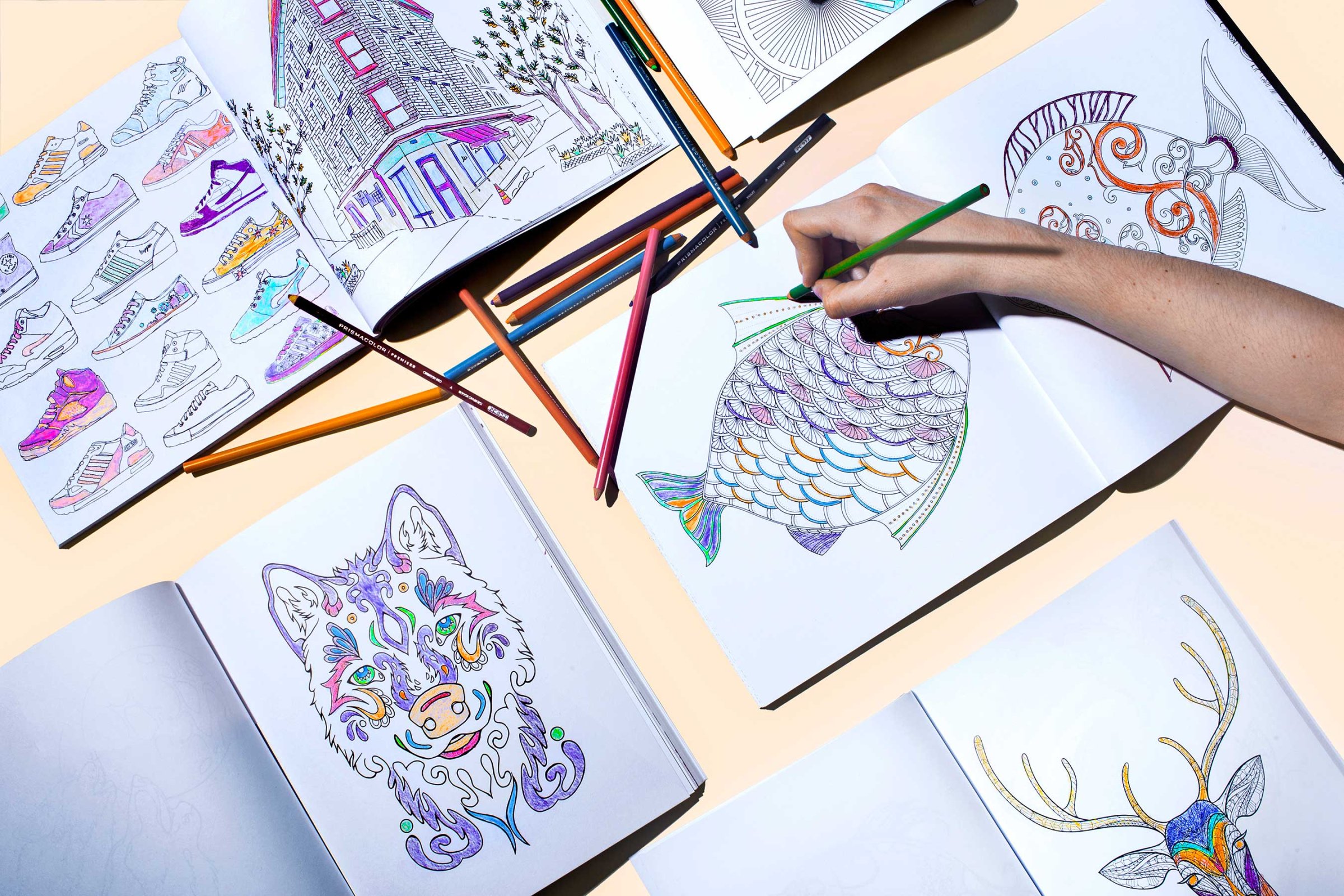
A few years ago, Scottish illustrator Johanna Basford made her living creating complex black-and-white drawings for brands like Nike and Absolut Vodka. Her clients would joke about wanting to color them in, and though she knew “they were being quite flippant,” she says it gave her an idea: she began drafting a coloring book and told her publisher she wanted to target it to adults. Secret Garden: An Inky Treasure Hunt and Coloring Book debuted in 2013 with an initial printing of 13,000 copies. Three years later, Basford has published two more books. Total worldwide sales: 16 million.
Grownups today ride scooters, read books written for teens and flock to restaurants that offer haute versions of kids’-menu staples like mac and cheese. Perhaps it should come as no surprise then that coloring books for adults have become a trend. The genre has been around for at least four decades–the assiduously low-cost press Dover Books has been making them since 1970–but Basford’s success made it a phenomenon. According to industry research firm Nielsen BookScan, U.S. sales of coloring books of all sorts jumped from 1 million in 2014 to 12 million in 2015. Nielsen doesn’t break out adult- from youth-oriented books, but best sellers include Escheresque motifs, intricate animalia and architecture, and tie-ins with franchises like Game of Thrones. And themes can veer into the mature, such as Swear Word Adult Coloring Book or Grimm Fairy Tales Adult Coloring Book, which renders Red Riding Hood and Cinderella as pinups.
Nielsen’s December survey found that 71% of adult colorers are female. While there’s a considerable millennial contingent–36% are ages 18 to 29–boomers enjoy coloring too, with 19% being over 55. Celebrities like Zooey Deschanel and Nigella Lawson are supposedly fans, while others are the stars of single-subject books, including Drake, Benedict Cumberbatch and Ruth Bader Ginsburg. The trend has spawned coloring contests, a new National Coloring Book Day (Aug. 2 in the U.S.) and social-media pages for sharing completed pictures. Alex Perruzzi, Barnes & Noble’s vice president with responsibility over the genre, believes sales will continue to grow over the next couple years. “We’re going to hit a plateau,” he says. “But it’s going to last awhile.”
Why are so many adults shelling out money and taking the time to pick up an activity most left behind right around the time they learned to tie their shoes all on their own?
Many claim coloring promotes mental well-being. Bestselling coloring books for adults include words like calm or stress relieving in their titles: Stress Relieving Patterns or, less chill, Calm the F*ck Down. Staying inside the lines, especially in more complex illustrations, takes a lot of concentration, which blocks out distraction. In this sense, coloring could be a species of mindfulness like meditation, which has been shown to reduce stress. Benefits of true mindfulness include everything from reduced blood pressure to increased immune strength, according to scientists.
Stephanie Pratola, a clinical psychologist, says coloring can put people in a state of “flow.” The mesmerizing swish of the pencil “is hard enough to absorb you,” says Pratola, “but not so hard that you’re going to fail. That’s the best state to be in. That really feels good to people.”
And it does feel pretty good. After a particularly painful visit to the dentist, I found myself hunched over Lost Ocean, Basford’s most recent coloring book. I forgot about my throbbing molar, fretting instead about color selection for each minuscule fish. I colored in the lines with the kind of attention to detail usually left to spreadsheets and taxes. In a world that’s constantly interrupted by the beeping and buzzing of notifications, I found myself getting pleasantly lost in the intricacy of the ornate pages.
But if you have the kind of type-A personality that tends to send you into obsessions, it’s easy to see how coloring can become addictive. One enthusiast, 27-year-old Lisa Gilbert, says she’ll work on the same picture every night for days in a row, until her wrist gets too strained and she has to take a few days off. “Gosh, this makes me sound really lame,” she says.
The fact that coloring is so frankly childish may not be something to get over but actually a big reason for doing it in the first place, like revisiting a favorite animated film through older, more sentimental eyes. Gilbert says a big part of the charm is how strongly the books evoke her childhood. “I really associate them with my grandmothers’ houses,” she says, explaining that she’s drawn to “that sort of nostalgic feeling.” It also functions as an arts-and-crafts session: Gilbert once thought she’d pursue fine arts but now works in environmental education. “Coloring books are probably filling that hole for me,” she says. “I feel like I’m getting my creative juices flowing without having to fill a blank page.”
If coloring fans see the activity as a way to express their creativity, illustrators like Basford see their customers as artistic partners. “I might draw those black-and-white outlines, but the pictures aren’t complete until people have brought them to life with color,” she says. “It kind of blows my mind that I have this opportunity to collaborate with millions of people all over the world. I can’t think of many creative people in the past who’ve had that opportunity.”
More Must-Reads from TIME
- Cybersecurity Experts Are Sounding the Alarm on DOGE
- Meet the 2025 Women of the Year
- The Harsh Truth About Disability Inclusion
- Why Do More Young Adults Have Cancer?
- Colman Domingo Leads With Radical Love
- How to Get Better at Doing Things Alone
- Michelle Zauner Stares Down the Darkness
Contact us at letters@time.com